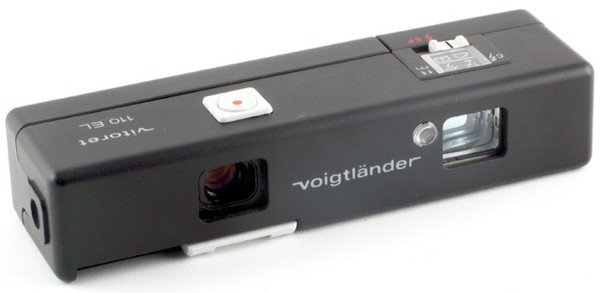

Fixed focus f/5.6 "Lanthar" lens of unknown focal length. No meter. Black body. Four adjustable f/stops denoted by a confusing set of symbols for weather and distance. When you finally figure it out, everything is "OK". The same f-stop setting works for estimating distances to go with a standard AG-1 flash gun. Film advance by pushing on a white tab under the lens. Nice viewfinder. Leatherette case with velcro on flap and a wrist strap. Really clever little belt clip.
(1978 - 1981?) An automated version of the original manual Vitoret, the 110 EL's main claim to fame is its size -- even by current, keychain-sized camera standards it's impressively compact (4.8 x 1.4 x 1 inches). In its heyday, it was one of the smallest 110 cameras on the market, a feat achieved purely by careful packaging of the key elements (lens/shutter assembly, viewfinder, CdS meter and batteries) -- and without the Minox-style pump-action film advance. The lens is a 24mm f5.6 fixed-focus "Lanthar". The instructions claim a focus range from at least 5 feet to infinity. The shutter is electronic with speeds of 4 seconds - 1/30 sec. triggered by the CdS meter. If the batteries are removed the shutter defaults to 1/300 sec. The aperture is manually selected -- f5.6 or f11. The apertures are marked only by 'idiot' symbols which vary with the type of film inserted in the camera. With ISO 100 film, you can choose between SUN (f11) and CLOUDS (f5.6). With ISO 400 film, you can choose between CLOUDS (f11) and WINDOW for indoors (f5.6). The CdS meter is switched on by lightly pressing the shutter release button. The only indication of correct exposure is a red LED in the viewfinder -- if you see the LED the shutter-speed is too long for hand-held shots. If you don't see it, you're OK. There's no information about what shutter-speed is deemed too slow for hand-held shots. The LED also lights up for as long as the shutter is open. In this instance, just unscrew the hand-strap and the socket becomes a standard tripod connection. The camera uses two A76 batteries. Other features include parallax markings in the viewfinder, a hot-shoe for flash use and a built-in lens/viewfinder cover. A white plastic slider-button on the front lower edge advances the film and sets the shutter. It also opens and closes protective covers for the lens & viewfinder and locks the shutter release. A matching flash unit was also available. In terms of aesthetics it's a rather engaging piece of 1970s teutonic 'Austerity Chic' -- an uncluttered little black box with slightly rounded edges, and a minimum of controls. But what can you expect in a package this small?

To return to the main index for the Sub Club click here.
COPYRIGHT @ 1995, 1996, 1997, 1998, 1999, 2000, 2001, 2002, 2003, 2004, 2005 by Joe McGloin. All Rights Reserved.